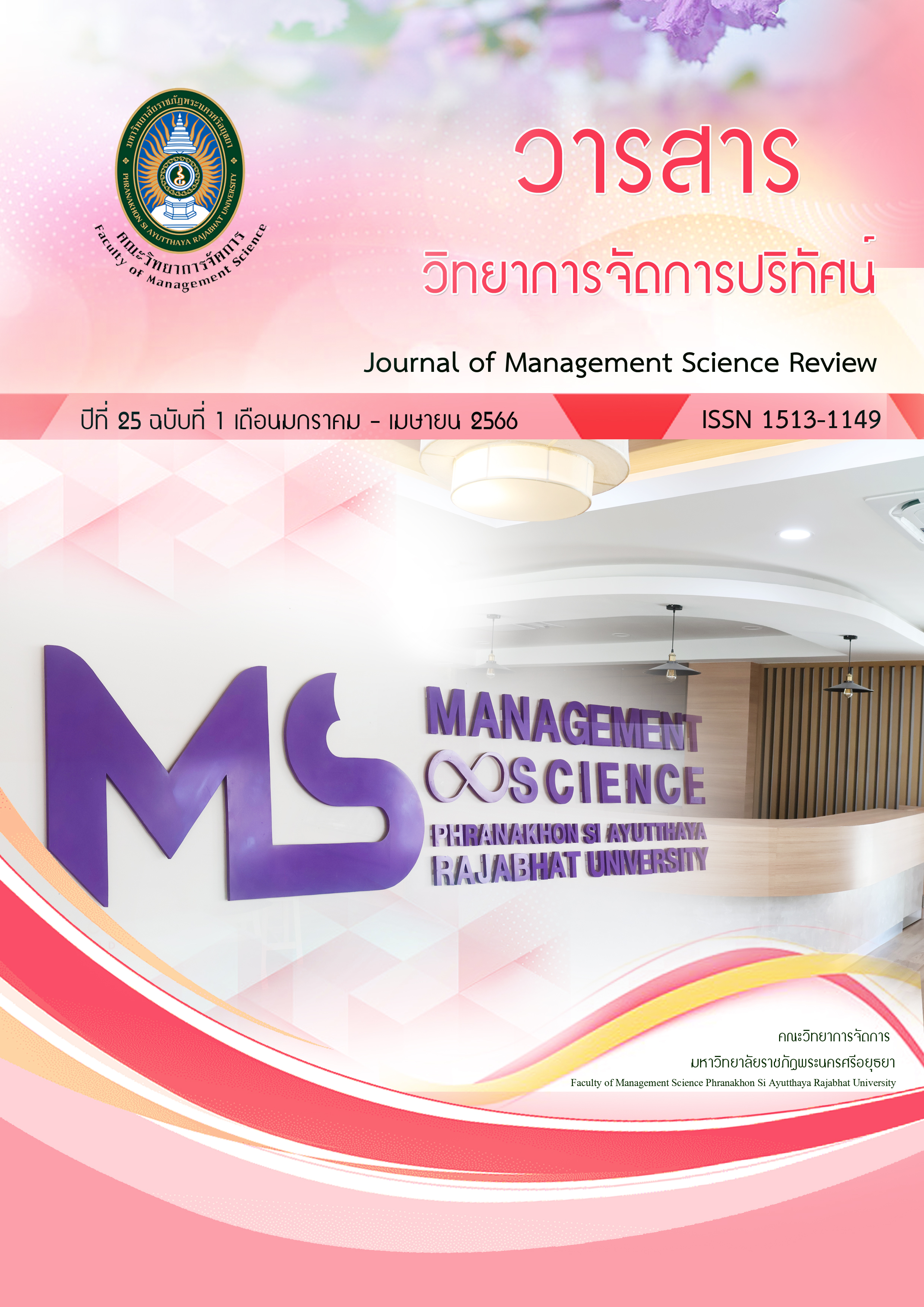Guidelines for Developing Tie-dye Occupation Group Competitive Advantages Using a Business Model
Keywords:
Competitive Advantage, Occupational Group, Tie-dye, Business ModelAbstract
The objectives of this research were: 1) to examine the context and current situation of the tie-dye occupation groups in the Bang Khayang Subdistrict, Muang District, Pathum Thani Province; 2) to develop products by naming and designing tie-dye products; and 3) to create a business model canvas for the tie-dye occupation group in Bang Khayang Subdistrict, Mueang District, Pathum Thani Province. Data was gathered from the members of the tie-dye occupation group through participatory qualitative research. The study's conclusions showed that: 1) Community members from the Bang Khayang Subdistrict, Mueang District, Pathum Thani Province joined forces to form the tie-dye occupation group, which they did in order to make money jointly. Starting with the group members' preferences for tie-dye products. Group members have studied and learned by themselves, and a government agency had come in to inform them of the procedures and methods of tie-dying. The design of the product was continuously distributed with a focus on quality and vibrant colors. 2) Product development by naming and branding, the members of the tie-dyeing group shared the name and brand’s characteristics, which made them aware of the need for and significance of the name and brand that would convey the tie-dyeing group occupation, Bang Khayang subdistrict. 3) There were 3 ways to find a way to create a competitive advantage for the tie-dye occupation group with a business model canvas: 1) by creating a difference in quality, 2) by marketing to specific groups of customers, and 3) by sales through online channels.
References
กิตติคุณ นิมิตแสงเทียน, พิชญา ตันติอำไพวงศ์ และกุลกนิษฐ์ คุณาธิกรกิจ. (2561). การพัฒนาแบบ จำลองธุรกิจเชิงกลยุทธ์ธุรกิจค้าวัสดุและอุปกรณ์ก่อสร้าง. ใน การประชุมวิชาการระดับ ชาติและนานาชาติด้านบริหารธุรกิจและการบัญชี 2561. นวัตกรรมเพื่อการเปลี่ยนแปลงองค์กร สู่การดำเนินธุรกิจที่ยั่งยืน. (หน้า 397-413). ขอนแก่น: มหาวิทยาลัยขอนแก่น.
กนกวรรณ ไทยประดิษฐ์ และฐะปะนีย์ ตรีรัตนภรณ์.(2559). เครือข่ายสังคมค้าขายออนไลน์: คุณลักษณะของความต่างที่เป็นตัวเลือกระหว่างเฟซบุ๊ก ไลน์และอินสตาแกรม. วารสารนักบริหาร, 36(2). 24-38.
เขมิกา ธนธำรงกุล และคณะ. (2563). โมเดลธุรกิจเพื่อสร้างความได้เปรียบในการแข่งขันของธุรกิจจำหน่ายเครื่องจักรกลการเกษตร ในจังหวัดเชียงใหม่. วารสารวิชาการมหาวิทยาลัยราช ภัฏศรีษะเกษ, 14(2). 51-62.
ชลกาญจน์ สถะบดี. (2564). การศึกษาองค์ประกอบทักษะการเรียนรู้ในศตวรรษที่ 21 กลยุทธ์การตลาดเพื่อเพิ่มศักยภาพผลิตภัณฑ์ชุมชนศิลปะประดิษฐ์และของที่ระลึกเซรามิค โดยใช้ภูมิปัญญาแบบผสมผสานด้วยแบบจำลองธุรกิจ. วารสารมหาวิทยาลัยนราธิวาสราชนครินทร์ สาขามนุษยศาสตร์และสังคม ศาสตร์, 8(1), 174-193.
ฐาปนา ฉินไพศาล. (2559). องค์การและการจัดการ. นนทบุรี: ธนธัชการพิมพ์.
มนสิชา อนุกูล. (2565). แนวทางการจัดการส่งเสริมกลุ่มอาชีพชุมชน ตำบลบางขะแยง อำเภอเมือง จังหวัดปทุมธานี. วารสารวิทยาการจัดการปริทัศน์, 24(1), 137-146.
รัฐพล ภุมรินทร์พงศ์ และคณะ. (2562). การพัฒนาอาชีพกลุ่มผู้นำสตรี ชุมชนบ้านสันติสุข ตำบลน้ำริม อำเภอเมือง จังหวัดตาก. วารสารวิชาการรับใช้สังคม มหาวิทยาลัยเทคโนโลยีราชมงคลล้านนา, 3(2), 55-63.
ศิริวรรณ เสรีรัตน์ และคณะ. (2546). การบริหารการ ตลาดยุคใหม่. กรุงเทพฯ: ธีระฟิล์มและไซเท็กซ์.
สมพันธ์ เตชะอธิก. (2540). การพัฒนาความเข้มแข็งขององค์กรชาวบ้าน. ขอนแก่น: สถาบันวิจัยและพัฒนา มหาวิทยาลัยขอนแก่น.
Osterwalder, A. and Pigneur, Y. (2009). Business Model Generation. Amsterdam, Netherlands: Modderman Drukwerk.
Porter, M.E. (1985). Competitive strategy techniques for analyzing industries and competitors. New York: Free press.





